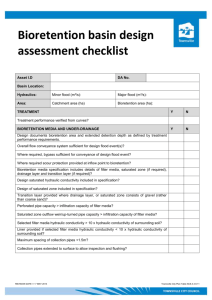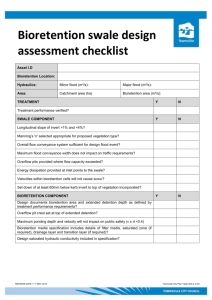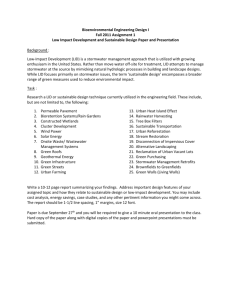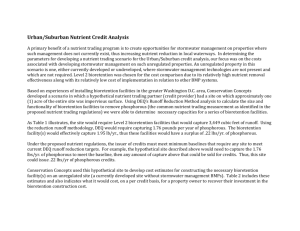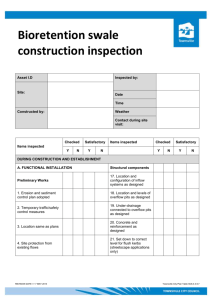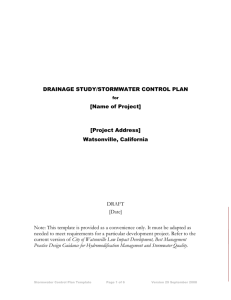Bioretention saturated zones: do they work at the large-scale?
advertisement
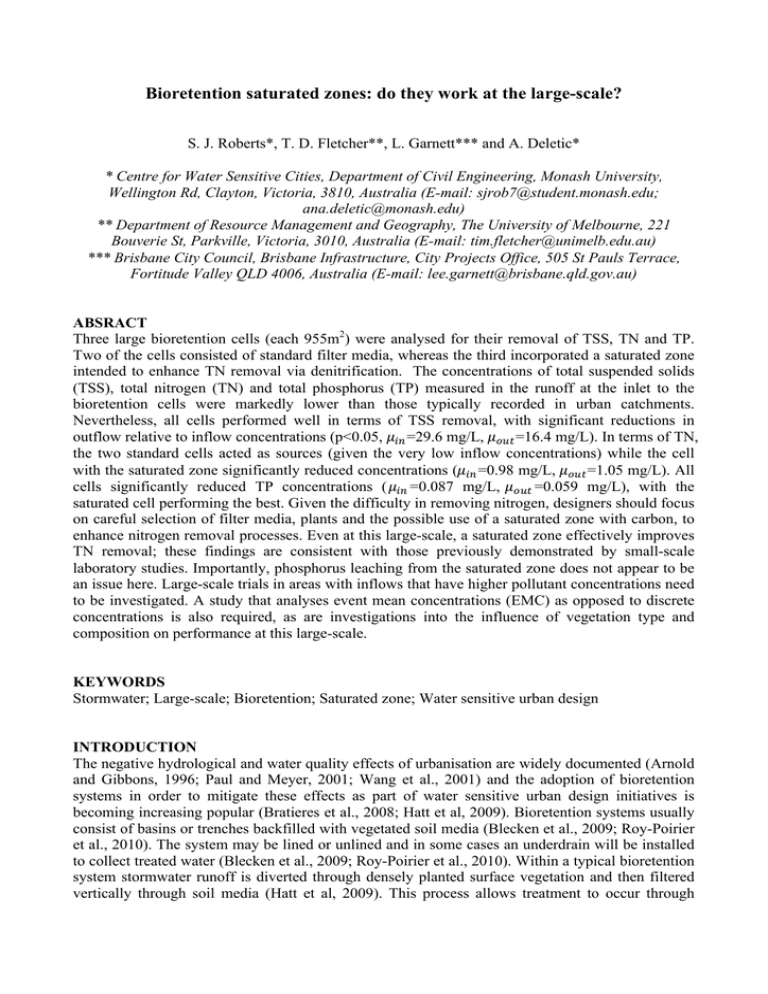
Bioretention saturated zones: do they work at the large-scale? S. J. Roberts*, T. D. Fletcher**, L. Garnett*** and A. Deletic* * Centre for Water Sensitive Cities, Department of Civil Engineering, Monash University, Wellington Rd, Clayton, Victoria, 3810, Australia (E-mail: sjrob7@student.monash.edu; ana.deletic@monash.edu) ** Department of Resource Management and Geography, The University of Melbourne, 221 Bouverie St, Parkville, Victoria, 3010, Australia (E-mail: tim.fletcher@unimelb.edu.au) *** Brisbane City Council, Brisbane Infrastructure, City Projects Office, 505 St Pauls Terrace, Fortitude Valley QLD 4006, Australia (E-mail: lee.garnett@brisbane.qld.gov.au) ABSRACT Three large bioretention cells (each 955m2) were analysed for their removal of TSS, TN and TP. Two of the cells consisted of standard filter media, whereas the third incorporated a saturated zone intended to enhance TN removal via denitrification. The concentrations of total suspended solids (TSS), total nitrogen (TN) and total phosphorus (TP) measured in the runoff at the inlet to the bioretention cells were markedly lower than those typically recorded in urban catchments. Nevertheless, all cells performed well in terms of TSS removal, with significant reductions in outflow relative to inflow concentrations (p<0.05, !!" =29.6 mg/L, !!"# =16.4 mg/L). In terms of TN, the two standard cells acted as sources (given the very low inflow concentrations) while the cell with the saturated zone significantly reduced concentrations (!!" =0.98 mg/L, !!"# =1.05 mg/L). All cells significantly reduced TP concentrations (!!" =0.087 mg/L, !!"# =0.059 mg/L), with the saturated cell performing the best. Given the difficulty in removing nitrogen, designers should focus on careful selection of filter media, plants and the possible use of a saturated zone with carbon, to enhance nitrogen removal processes. Even at this large-scale, a saturated zone effectively improves TN removal; these findings are consistent with those previously demonstrated by small-scale laboratory studies. Importantly, phosphorus leaching from the saturated zone does not appear to be an issue here. Large-scale trials in areas with inflows that have higher pollutant concentrations need to be investigated. A study that analyses event mean concentrations (EMC) as opposed to discrete concentrations is also required, as are investigations into the influence of vegetation type and composition on performance at this large-scale. KEYWORDS Stormwater; Large-scale; Bioretention; Saturated zone; Water sensitive urban design INTRODUCTION The negative hydrological and water quality effects of urbanisation are widely documented (Arnold and Gibbons, 1996; Paul and Meyer, 2001; Wang et al., 2001) and the adoption of bioretention systems in order to mitigate these effects as part of water sensitive urban design initiatives is becoming increasing popular (Bratieres et al., 2008; Hatt et al, 2009). Bioretention systems usually consist of basins or trenches backfilled with vegetated soil media (Blecken et al., 2009; Roy-Poirier et al., 2010). The system may be lined or unlined and in some cases an underdrain will be installed to collect treated water (Blecken et al., 2009; Roy-Poirier et al., 2010). Within a typical bioretention system stormwater runoff is diverted through densely planted surface vegetation and then filtered vertically through soil media (Hatt et al, 2009). This process allows treatment to occur through several mechanisms including fine filtration, sorption, microbially mediated transformations and biological uptake (Jaffe, 2010; Roy-Poirier et al., 2010). Studies typically indicate that bioretention systems are very efficient at removing sediments and heavy metals (Davis et al., 2009; Trowsdale and Simcock, 2011). However, in terms of nutrients (e.g. nitrogen and phosphorus) the treatment performance of these systems has been more variable (Davis et al., 2009). These findings are predominantly based on laboratory-based studies (Trowsdale and Simcock, 2011) and hence are not entirely indicative of how bioretention systems perform under field scale conditions (Hatt et al., 2008). As a result there is a need for further research into the in situ performance of bioretention systems at the field scale. Although several field scales studies have been conducted (e.g., Davis, 2007; Yang et al., 2009; Brown and Hunt, 2011) these have typically investigated relatively small-scale bioretention systems (e.g., 26.4m2; 13.9m2; 206-290m2 respectively). As a result, there is an even greater need for field-based studies that investigate the water quality performance of large-scale bioretention systems. This paper presents the findings of a study into the treatment performance of three hydraulically separate bioretention cells that form part of a regional scale bioretention system located in Queensland, Australia. Collectively, the total treatment area of this system is 2865m2 (955m2 per cell). Two of the bioretention cells consist of standard filter media whereas one cell incorporates a saturated drainage layer with an organic carbon source. The ability of each cell to reduce the concentration of total suspended solids (TSS), total nitrogen (TN) and total phosphorus (TP) in stormwater runoff is examined. METHODS Site Description and Layout The studied bioretention system is located in Wakerley, Queensland and treats stormwater runoff from a primarily low density residential catchment (87ha). This system consists of a sedimentation pond (995m2) feeding a bioretention basin with a total treatment area of 2865m2. The bioretention basin consists of three bioretention cells (955m2 per cell) that are separated by vegetated bunds (Figure 1). The sedimentation pond has a maximum depth of 1.5m and is designed to remove 70% of particles of 125 microns or greater in size. Three box culverts split flows leaving the sedimentation pond; rock beaching at the culvert outlets allows for the spreading of concentrated flows before they enter each cell. The rock bleaching also maintains flow velocities below 0.5m/s for discharges up to the design operation flow (1.0 m3/s) and below 1.5m/s for discharges above design flows (2.5m3/s, 50 yr ARI). All dry weather base flows leaving the sedimentation pond are diverted into cell 3 in order to mitigate the risk of the saturated zone within the drainage layer of this cell drying out. As stormwater enters each bioretention cell it comes into contact with dense vegetation before percolating through soil-based filter media. A maximum ponding depth of 0.3m is provided in order to increase the volume of runoff percolated through the system. Treated stormwater is collected in perforated subsurface drainage pipes and conveyed to the Tilley Road culverts before entering a natural tributary of Lota Creek. When the maximum ponding depth is exceeded overflow pits allow for the egress of stormwater. In the event that design flood flows are exceeded (3.7m3/s, >100yr ARI) a high flow bypass is activated and runoff from the sedimentation pond is diverted away from the bioretention basin in order to protect vegetation from scour. Figure 1. Location of monitoring points at the Wakerley site. (Modified from Water Management City Design, 2007) Bioretention Cell Structure In each cell the same filter media is used (saturated hydraulic conductivity of 100mm/hr) but the transition and drainage layers vary in terms of depth and material. Cells 1 and 2 have a drainage layer that consists of a 100mm thick layer of gravel (5mm) placed around subsurface drainage pipes followed by a 100mm thick upper ‘transition layer’ of clean coarse sand (1-2mm, minimum saturated hydraulic conductivity of 4000+mm/hr). The drainage layer of cell 3 was designed to incorporate an additional saturated zone and includes a 900mm layer of pre-mixed material consisting of rock, woodchips and bio-solids (Table 1). The bio-solids seed the system with denitrifying bacteria while the wood chips act as a source of organic carbon to fuel microbial denitrification. The transition layer in cell 3 consists of a 150mm thick layer of 5mm gravel beneath a 150mm thick layer of clean coarse sand (1-2mm). The single ring infiltration test was used to assess hydraulic conductivity (FAWB, 2009). Table 1. Cell 3 drainage layer (modified into a saturated zone). Material Volume of Drainage Layer [%] 50 mm durable/resistant rock 60 5 mm hardwood Eucalypt wood chips 35 Bio-solids from sewer treatment plant 5 The subsurface pipes at the base of cells 1 and 2 have been laid on a 0.5% grade, with the exception of cell 3, where the pipe is laid flat. In this cell, the elevated outlet ensures that all water within the saturated zone is treated for three hours before being discharged. The vegetation also varies from cell to cell (Figure 2). Each cell is divided into 11 vegetation zones, five have canopy cover (zones 3, 4, 6, 7, 8), five have no canopy cover (zones 1, 2, 9, 10, 11) and one contains a heavily-planted edge (zone 5). The heavily planted edges are located at the culvert inlets in order to attenuate the velocity of incoming stormwater. Figure 2. Vegetation layout for each bioretention cell. (Modified from Environment Management City Design, 2009) Data Collection Flows and water quality were monitored at the Wakerley site from April 2009 to March 2010; the location of each monitoring site is depicted in Figure 1. All flows were measured continuously on a 5 or 10 minute time step. Sigma 900 automatic samplers were used at the cell outlets (C1.2, C2.2, C3.2) and at the inlet to cell 3 (C3.1) to monitor flows and take flow weighted samples. Sigma 930 flow sensors (no samplers) were used to measure flows at the inlets to cells 1 and 2 (C1.1 and C2.1). Flow weighted samples were only taken at the inlet to cell 3 (C3.1) as concentrations of pollutants entering each cell was assumed to be uniform. Flows at the inlet of the sedimentation pond (SP) were measured with an Argonaut water flow monitoring device and samples were taken with a Sigma 900 automatic sampler. An Argonaut was required because of the irregular shape of the inlet channel leading into the sedimentation pond. Level sensors in each of the bioretention cells monitored the extended detention depth and were used to indicate high flow bypass occurrences. Event rainfall volume was recorded by a rainfall gauge located at the centre of the site. Water quality samples were analysed for a range of parameters, however, the majority of samples were only analysed for TSS, TN and TP. There was considerable variation in the total number of samples analysed per event and per cell and on some occasions composite samples were taken in addition to discrete samples. Analyses were undertaken by the NATA-accredited Brisbane Water Scientific Analytical Services facility. Data Analysis In order to assess the performance of each cell an analysis of discretely-taken water quality samples collected between 28/04/2009 and 11/03/2010 was conducted. The total number of samples analysed from the inlet (C3.1) and the outlet of cells 1, 2 and 3 (C1.2, C2.2 and C3.2) was 65, 53, 60 and 74 respectively. Flow data from the inlets and outlets of cell 1 were used to determine the start and end of events for all three cells, to ensure consistency (this was done after checking that no significant differences existed between the three cells). The start of each event was identified as the point in time when the following two criteria were satisfied (1) discharge exceeded 0.5L/s and (2) discharge during each of the ten previous time steps was below 0.5L/s. The end of each event was identified as the point in time when the following two criteria were satisfied (1) discharge transitioned from greater than 0.5L/s to less than 0.5L/s and (2) discharge remained below 0.5 L/s for at least the next ten time steps. An example of the implementation of this procedure is provided below in Figure 3. For several reasons this system of event identification is not entirely accurate. The distance between the sedimentation pond outlet and the inlet of each cell is variable so it is likely that there will be slight variations in the start and end time of events across the three cell inlets. Consequently, the assumption that runoff events in cells 2 and 3 begin and end at the same time as events in cell 1 is simplistic. However, the most significant issues are associated with event identification at the cell outlets. The lag time between runoff entering and leaving each cell will not be constant because runoff velocity will be influenced by the different layout, structure and size of vegetation in each cell. Additionally, as dry weather base flows are only diverted into cell 3, it is expected that the moisture content of the media in cell 3 will be higher than the other cells. Higher moisture contents in cell 3 are expected to reduce infiltration and increase runoff. Consequently, it is unlikely that the start and end of discharge events at each cell outlet are exactly the same, particularly for cell 3. Figure 3. Example of the event identification process. Despite its shortcomings, this method of event identification was deemed to be the most appropriate and was adopted for the majority of events. On two occasions minor variations to this system had to be made due to restrictions imposed by data quality and availability. The SPSS 19 package was used to analyse all discrete flow weighted water quality samples. The normality of the distribution of the datasets was checked by visually inspecting histograms of the data and by implementing One-Sample Kolmogorov-Smirnov tests (significance accepted at p < 0.05). Log10 transformations were applied to data not satisfying the assumption of normality. The data was then checked for homogeneity of variance using Levene’s test before a One-Way ANOVA was conducted (significance accepted at p < 0.05). Based on the results of the homogeneity tests, post-hoc comparisons were conducted with either the Tukey HSD or Tamhane methods. RESULTS AND DISCUSSION Relative to the inlet, all cells significantly reduced TSS and TP mean concentrations (Table 2). Cells 1 and 2 acted as sources of TN, due to very low inflow concentrations, whereas cell 3 significantly reduced TN concentrations. The concentrations of TSS leaving each cell satisfy the water quality objectives for the receiving water (Lota Creek). However, no cells meet the objectives for TN and TP. Based on a consideration of mean concentrations, percentage reductions and the Lota Creek water quality objectives cell 3 appears to be the optimal cell of the three studied. Table 2. Bioretention cell inflow and outflow pollution levels. Pollutant TSS [mg/L] Parameter Inlet Cell 1 outlet Cell 2 outlet Cell 3 outlet Median 23.0 12.0 10.0 11.0 Mean (!) 29.6 18.9 13.8 16.5 Coefficient of Variation (CV) 0.093 0.135 0.125 0.128 6.0 - 120.0 2.5 - 73.5 2.5 - 60.0 2.5 - 120.5 Skewness 2.06 1.82 1.91 2.99 Median 0.83 1.10 0.97 0.74 Recorded Range Mean (!) 0.98 1.26 1.09 0.79 Coefficient of Variation (CV) 0.058 0.069 0.056 0.053 0.36 - 2.30 0.51 - 4.20 0.41 - 2.20 0.30 - 2.4 Skewness 1.09 2.44 1.06 1.64 Median 0.069 0.050 0.053 0.034 Mean (!) 0.087 0.065 0.057 0.054 Coefficient of Variation (CV) 0.609 0.710 0.636 1.429 0.020 - 0.260 0.020 - 0.230 0.014 - 0.210 0.005 - 0.620 Skewness 1.34 2.22 2.38 5.84 Approximate Standard Error of Skewness 0.30 0.34 0.32 0.28 TN [mg/L] Recorded Range TP [mg/L] Recorded Range Inflow Concentrations Prior to entering the bioretention system untreated stormwater flows passes through a sedimentation pond. The treatment performance of the sedimentation has not been assessed as only a small number of water quality samples were taken at the pond inlet and due to the poor quality of flow measurements taken at this location. Consequently, the treatment performance of the bioretention cells has been assessed relative to the inflow concentrations recorded at the inlet of the bioretention system, downstream of the sedimentation pond. The concentrations of TSS, TN and TP recorded at the inlet of the bioretention system are markedly lower than those typically measured in high urban and residential catchments (Table 2 and Table 3). This may indicate that, relative to other developed areas, the runoff from the primarily residential catchment that feeds into the Wakeley bioretention system is quite clean. However, it may also be a result of significant treatment occurring within the sedimentation basin. Regardless, the potential for high percentage reductions in pollutant concentrations within the bioretention system is thus likely to be low. However, it should also be noted that the behaviour of the system inlet is likely to be the most ‘flashy’ of all points monitored, given the high flow rates and likely variable concentrations of pollutants from the upstream catchment. Consequently, the interpretation of the inlet concentrations and any comparisons with (i) other stormwater quality studies and (ii) the outlet concentrations from the bioretention cells (where the flow and concentrations are both likely to be much more buffered) should be undertaken with care. It is indeed possible that the sampling does not always capture the peak concentration at the inlet, meaning that both concentrations and loads at the inlet are underestimated. Table 3. Urban stormwater quality statistics (Fletcher et al., 2004). Concentration [mg/L] Land use Pollutant Median Mean (!) High Urbana TSS 152 294 a High Urban TN 2.5 3.4 Residentialb TP 0.39 0.56 a Areas of land >66% urban b Urban catchments where >66% is classed as residential Outflow Concentrations The mean inlet TSS concentrations are significantly higher than the corresponding mean outlet concentrations across all cells (ANOVA and post-hoc p<0.05), with cell 2 recording the lowest and least variable concentrations. Hence, although all cells significantly reduce TSS concentrations, cell 2 recorded the best performance. The positive skewness of inlet and outlet TSS concentrations indicate that high concentrations of TSS were relatively rare. Consequently, an analysis of event mean concentrations (EMC) is desirable, as it would facilitate a better understanding of the significance of these occasional high TSS concentrations on loads. The performance of the three bioretention cells varied markedly in relation to TN. Cell 3 recorded significantly lower mean TN concentrations relative to the inlet and the other cells whereas cells 1 and 2 both acted as sources of TN. While the vegetation planted in cell 3 is slightly different to that found in cells 1 and 2, these results are most likely attributable to the inclusion of a saturated zone in the drainage layer in Cell 3. Furthermore, although the removal performance of cells 1 and 2 is poor, the outlet concentrations are actually quite low relative to typical stormwater values. The good performance of cell 3 for nitrogen removal suggests that leaching of nitrogen from the biosolids introduced to seed the system is not a problem. The saturated zone improves nitrogen retention through a combination of enhancing denitrification, prevention of drying out and by increased detention times (Zinger et al., 2007a,b). Unlike cell 2, the increase in TN concentrations leaving cell 1 were significant. The structure of cells 1 and 2 provides an insight into the basis for this variation. The filter media, transition layer, drainage layer and proportions of canopy cover in cells 1 and 2 are the same. Consequently, the greater degree of TN leaching from cell1 relative to cell 2 may be attributed to the different vegetation present in the two cells. Four of the eleven zones in cells 1 and 2 were planted with different species of vegetation. Cell 1 was planted with two zones of Ficnia nodosa and two zones of Cyperus exaltatus while cell 2 was planted with two zones of Lomandra hystrix and two zones of Gahnia sieberiana. Obvious preferential flow paths have developed in cell 1; this allows some runoff to bypass the system. Furthermore, inspections have identified a greater loss of plants in cell 1 relative to the other two cells. The development of preferential flow paths and the loss of vegetation may also be responsible for the poorer performance of cell 1. All three cells significantly reduce TP concentrations relative to the inlet, with cell 3 also recording significantly lower concentrations than cell 1. Cell 3 has the lowest mean and median concentrations, but is more variable (Table 2). Generally, each cell produces ‘steady’ outflow concentrations, suggesting the reaching of ‘irreducible’ or ‘background’ TP concentration levels. The fact that cell 3 has relatively low TP outlet concentrations, despite its deep saturated zone with organic matter, suggests that leaching of phosphorus from the saturated zone is, at least in this case, not likely to pose a problem. Receiving Water Bodies The bioretention system was designed to achieve site-specific load based objectives, however, a comparison to these objectives is not possible due to inconsistent flow data. In order to allow for some assessment of the results a comparison with concentration based water quality objectives has been made. Notably, stormwater concentrations should not necessarily be required to comply with the water quality objectives set the in-stream conditions of receiving water bodies. Rather, stormwater runoff may arguably only need to be treated to a level such that when it is diluted with filtered baseflows, the combined outcome meets the relevant water quality objectives. The studied bioretention system discharges into a natural tributary of Lota Creek, a middle estuary water type that adjoins Waterloo Bay, consequently the water quality objectives presented in Table 4 are relevant (Queensland Water Quality and Ecosystem Health Policy Unit, 2010). Table 4. Water quality objectives relevant to Lota Creek. Median Concentration [mg/L] Classification Suspended solids TN TP Middle estuary <20 <0.300 <0.025 Area W2 - Western Bay - Waterloo Bay Not specified <0.200 <0.030 The mean concentration of TSS leaving all three cells satisfies the objectives set for suspended solids. All cells fail to meet the objectives set for TN concentrations. The discharge from cell 3, with a mean TN concentration of 0.79 mg/L, is the closest to meeting the objectives. Additionally, as the mean concentration of TP at the outlet of all the cells is above 0.050 mg/L, none of the cells meet the objectives in place for TP concentrations. It appears that cell 3 is the optimal bioretention cell of the three studied as it recorded the lowest TN and TP concentrations and, although it only recorded the second lowest TSS concentrations, it still met TSS receiving water quality objectives. CONCLUSIONS AND RECOMMENDATIONS 1. Even at this large-scale, a saturated zone effectively improves TN removal; these findings are consistent with those previously demonstrated by small-scale laboratory studies. 2. Given the difficulty in removing nitrogen, designers should focus on careful selection of filter media, plants and the possible use of a saturated zone with carbon, to enhance nitrogen removal processes. 3. As currently designed, bioretention systems cannot reduce TN levels to the prescribed estuary standard of 0.3 mg/l. 4. Phosphorus leaching from the saturated zone does not appear to be an issue. Looking forward, an investigation into the performance of large-scale bioretention systems under higher inflow pollutant concentrations is desirable. Furthermore, an analysis of these systems that considers events mean concentrations as opposed to discrete concentrations is required, as are investigations into the influence of vegetation type and composition on performance at this largescale. ACKNOWLEDGEMENT This project was funded by the Water Resources and City Projects Office of Brisbane City Council. REFERENCES Arnold C.L. and Gibbons C.J. (1996). Impervious surface coverage: The emergence of a key environmental indicator. Journal of the American Planning Association, 62(2): 243-258. Blecken G.T., Zinger Y., Deletic A., Fletcher T.D., Viklander M. (2009. Impact of a submerged zone and a carbon source on heavy metal removal in stormwater biofilters. Ecological Engineering, 35(5), 769778. Bratieres K., Fletcher T.D., Deletic A., Zinger Y. (2008). Nutrient and sediment removal by stormwater biofilters: A large-scale design optimisation study. Water Research 42(14), 3930-3940. Brown R.A. and Hunt W.F. (2011). Impacts of Media Depth on Effluent Water Quality and Hydrologic Performance of Undersized Bioretention Cells. Journal of Irrigation and Drainage Engineering, 137(3), 132-143. Davis A.P., Hunt W.F., Traver R.G. and Clar M. (2009). Bioretention Technology: Overview of Current Practice and Future Needs. Journal of Environmental Engineering, 135(3), 109-117. Environment Management City Design (2009). Wakerley Bioretention System: Vegetation Monitoring Report 2009. Report for Water Resources, Brisbane City Council, Queensland. FAWB. (2009). Guidelines for Soil Filter Media in Bioretention Systems. Melbourne, Australia: Facility for Advancing Water Biofiltration. Fletcher T., Duncan H., Poelsma P., Lloyd S. (2004). Stormwater Flow and Quality and the Effectiveness of Non-proprietary Stormwater Treatment Measures - A Review and Gap Analysis. Technical Report 04/8, Cooperative Research Centre for Catchment Hydrology, Australia. Hatt B.E., Fletcher T.D. and Deletic, A. (2008). Hydraulic and pollutant removal performance of fine media stormwater filtration systems. Environmental Science and Technology, 42, 2535–2541. Hatt B.E., Fletcher T.D., Deletic A. (2009). Hydrologic and pollutant removal performance of stormwater biofiltration systems at the field scale. Journal of Hydrology, 365(3-4), 310-321. Jaffe M. (2010). Environmental Reviews & Case Studies: Reflections on Green Infrastructure Economics, Environmental Practice, 12(4), 357-365. Paul M.J. and Meyer J.L. (2001). Streams in the urban landscape. Annual Review of Ecology and Systematics, 32, 333-365. Queensland Water Quality and Ecosystem Health Policy Unit 2010, Environmental Protection (Water) Policy 2009: Redland Creeks environmental values and water quality objectives Basin No. 145 (part), including Coolnwynpin, Eprapah, Hilliards, Lota, Moogurrapum, Tarradarrapin, Tingalpa and Wynnum creeks, Department of Environment and Resource Management, Queensland. Roy-Poirier A., Champagne P. and Filion Y. (2010). Review of Bioretention System Research and Design: Past, Present, and Future. Journal of Environmental Engineering, 136(9), 878-889. Trowsdale S.A. and Simcock R. (2011). Urban stormwater treatment using bioretention. Journal of Hydrology, 397, 167-174. Wang L., Lyons J., Kanehl P. (2001). Impacts of urbanization on stream habitat and fish across multiple spatial scales. Environmental Management, 28(2), 255-266. Water and Management City Design (2007). Wakerley Bioretention System Monitoring Methodology. Report for Water Resources, Brisbane City Council, Queensland. Yang H., Florence D.C., McCoy E.L., Dick W.A. and Grewal P.S. (2009). Design and hydraulic characteristics of a field-scale bi-phasic bioretention rain garden system for storm water management. Water Science and Technology, 59(9), 1863-1872. Zinger, Y., Fletcher, T. D., & Deletic, A. (2007a). The recovery of nitrogen removal after different drying periods in biofilter systems. Paper presented at the Conference on Rainwater and Urban Design, Sydney, Australia, 21-23 August, 2007. Zinger, Y., Fletcher, T. D., Deletic, A., Blecken, G. T., & Viklander, M. (2007b). Optimization of the nitrogen retention capacity of stormwater biofiltration systems. Paper presented at the Novatech conference, Lyon, France, June 24-28, 2007. Volume 2, pp. 893-900.

